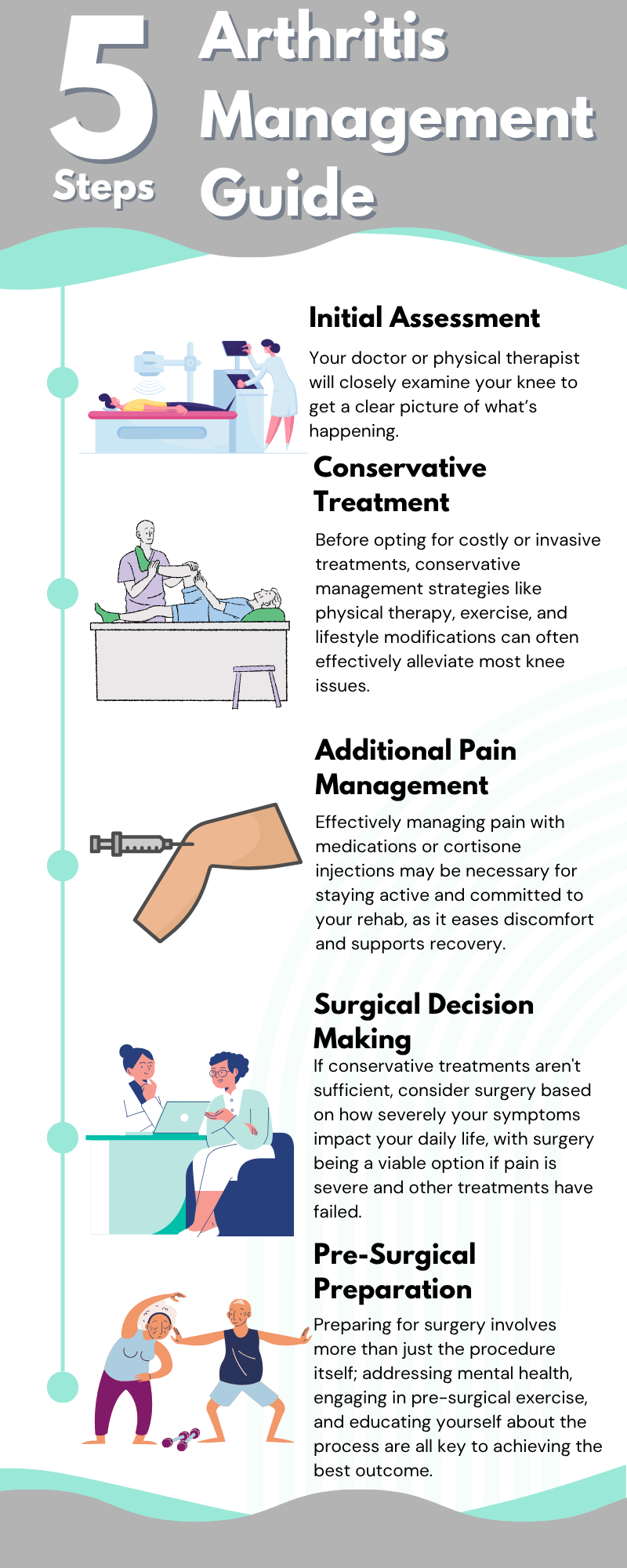Dealing with arthritis can be challenging, but with the right strategies, you can significantly reduce pain, improve mobility, and maintain your quality of life. While arthritis is a chronic condition, there are numerous non-surgical options to manage symptoms effectively and delay or avoid surgery. This guide walks you through the essential steps to manage arthritis, from your first doctor’s visit to pre-surgical preparation.
Step 1: Start with a Thorough Assessment
Understanding the severity and specifics of your arthritis is the first step toward creating an effective treatment plan.
-
Physical Examination: Your healthcare provider will evaluate your joint for instability, range of motion, and muscle strength. These factors guide the development of a personalized management plan.
-
Imaging: X-rays can reveal joint space narrowing, bone spurs, and other indicators of arthritis. In cases where more detail is needed, MRIs can assess cartilage and soft tissue health.
Step 2: Explore Conservative Treatments
Many patients find significant relief through non-surgical methods, which aim to reduce symptoms and improve joint function.
Physical Therapy
-
Strengthens the muscles to better support the joint.
-
Improves flexibility and overall mobility.
-
Delays or prevents the need for surgery.
Lifestyle Adjustments
-
Weight Loss: Every pound lost reduces stress on your joint by up to 4 pounds.
-
Low-Impact Activities: Engage in swimming, cycling, or yoga to stay active without straining your joints.
-
Supportive Gear: Use proper footwear or braces to reduce joint stress.
-
Healthy Habits: Staying hydrated, maintaining a balanced diet, and quitting smoking all contribute to better joint health.
Step 3: Manage Pain Effectively
Pain management is crucial for staying active and making the most of your therapy sessions.
Medications
-
NSAIDs (like ibuprofen) help reduce inflammation and manage pain.
-
Acetaminophen can be effective for pain relief without reducing inflammation.
Injections
-
Cortisone: Provides short-term relief for inflammation and pain. Most effective when combined with rehab.
-
Hyaluronic Acid: Acts as a joint lubricant, improving mobility and comfort for several months.
-
Platelet-Rich Plasma (PRP): May promote tissue healing and reduce pain, particularly in mild arthritis cases.
Step 4: Weigh Surgical Options
Surgery is a last resort and should only be considered when conservative treatments no longer provide relief.
-
Mild to Moderate Symptoms: Continue non-surgical management, as most patients find significant improvement with consistent therapy and lifestyle changes.
-
Severe Symptoms: If pain and disability impact your daily life despite treatment, surgical options like partial or total joint replacement may be necessary.
Step 5: Prepare for Surgery
If surgery becomes the best option, preparation is key to ensuring a successful outcome.
Mental Health Check
-
Address any anxiety or depression before surgery, as mental health can significantly influence recovery.
Pre-Surgical Physical Therapy
-
Strengthen your muscles and improve flexibility to set a strong foundation for post-surgery recovery.
Education and Planning
-
Understand the surgery and recovery process to reduce stress and stay committed to your care plan.
A Key Takeaway: Manage Pain to Stay Active
Pain can create a vicious cycle: discomfort leads to reduced activity, which causes stiffness, weakness, and even more pain. Breaking this loop is critical.
How to Break the Cycle
-
Stay on top of pain management through medications, injections, and physical therapy.
-
Keep moving with low-impact exercises to maintain joint flexibility and muscle strength.
-
Commit to consistent lifestyle changes for lasting results.
Therapeutic Edge
Managing arthritis doesn’t have to feel overwhelming. By starting with a thorough assessment, committing to conservative treatments, and staying proactive about pain management, you can improve your mobility and reduce discomfort. Whether you’re just beginning your arthritis journey or considering surgery, these steps can help you regain control and get back to doing the things you love.
If you’re unsure where to start, consult a physical therapist or your healthcare provider to develop a personalized plan tailored to your needs.










